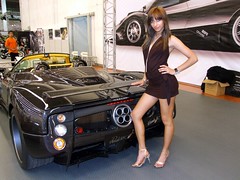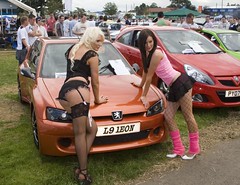Let’s face it, most family sedans are pretty darn boring. I would know, I have one. They are comfortable, well put together, efficient, spacious, economical, and about as fun as calculus. Bleh. Enthusiasts with the means generally steer clear of them like a nasty case of SARS. This category includes cars like the Camry, Altima, Sonata (arguable), Accord, Malibu, and other biegemobiles that give me narcolepsy. It’s entirely seperate from sports sedans, which generally have hefty pricetags, suck down copious quantities of 93 octane, cost more to insure than a house on the coastline, and go through rubber faster than a rock band’s lead singer. Think BMW 335i, Cadillac CTS 3.6DI, Acura TL SH-AWD, Audi S4, or Chrysler 300C.
So suppose you have the need and budget for a family sedan, but you don’t want to consign yourself to driving a biegemobile? Can you get a combination of practicality and frugality with some style, performance, and a reasonable price tag? Yes, it turns out, you can. Let me point you to the Volkswagen (Passat) CC.
The CC is a “four door coupe” in the style of the Mercedes-Benz CLS. What this means: swoopy, low roofline, frameless windows, and seating for four. The presence of four doors with the appearance of two. The CC has been around since 2008, and it slots in between the regular Passat and the (no longer sold here) Phaeton in VW’s sedan lineup.
Two engines in four trim levels are available: the 2.0T in Sport and Luxury trim, and the 3.6L 24v VR6 in VR6 Sport and VR6 4Motion trim. My test car was a 2010 CC Sport with the 2.0T and a six-speed manual transmission; which is the only trim level that three pedals are available with in the US market. Other markets get a smaller 1.8TSI engine as well as a pair of 2.0 TDI diesels; we miss out on those.
The strong suit of the CC is undoubtedly the styling. While it’s based on the sixth-generation Passat chassis (with which is shares a wheelbase), it’s 27mm longer, 50mm lower, and 36mm wider. So while a family resemblance is unmistakable, it has more of a squat, muscular stance than the somewhat staid Passat. The roofline is one smooth arc from the origin of the A-pillar to the termination of the C, with the rear windscreen integrated into the roofline much more smoothly than a normal sedan. The fluidic appearance of the CC is a stand-out in VW’s lineup; next to the dull new Jetta, conservative Passat, and strange-looking rides like the Tiguan and (urgh) Routan, the CC is a surprisingly attractive – dare I say sexy? – piece of equipment.
It’s one of the few new cars out there that 17″ wheels look just right on – probably due to the fender height to wheel well ratio. You can order alloys up to 19″ on the CC, but I recon that would absolutely ruin the ride. The CC has VW’s corporate “shield” grille, but it’s perhaps at it’s best-integrated here, where it seems to fit in with the angular lines of the CC’s front. It’s also not obnoxious bling bling chrome, which helps. The test car’s color is called Iron Grey Metallic, but to be honest it’s got a lot of blue to it. It comes across better to the eyes than it does in pictures, though. Still, compared to pretty much any other mainstream sedan out there, the CC is absolutely gorgeous. It’s different enough to attract attention, but not bizarre enough to repel it – if only all modern VW’s were this pretty!
So it’s pretty – what’s it like inside? Well, it’s interesting. You can tell it shares DNA with the Passat, but it’s different in a lot of ways. Primarily, the lack of headroom in the rear seats, as well as the presence of only four seatbelts. I’m a pretty tall guy – 6’2″ last time I checked – and my head was pressed quite firmly into the headliner when ensconced into one of the rear bucket seats. There’s no center seat in the rear, either – there’s a sliding-top console with some storage space and cupholders instead of a stiff pad and a lap belt. Considering how little headroom the outside rear passengers have, there’s probably a good reason they didn’t put a seat in the middle. It’s comfortable back there if you’re, say, 5’8″ – the rear buckets are actually quite supportive and there’s plenty of leg room – but that stylish roof line has to come from somewhere.
There are no qualms about the front seats, though. The CC is a seriously nice place to spend time behind the wheel. In typical German fashion, all the controls are where they’re supposed to be, easy to read, logically arranged, and everything feels high-quality. With the exception of the frameless windows, that is, which clatter like Subaru’s used to when you close the door. Ahh, there’s a price to pay for beauty. However, while we’re on the topic of the interior, I have to mention something I find disturbing.
Yeah, that’s the parking brake right there. No mechanical lever, no foot pedal to push, it’s a button. I’m not sure how I feel about this. While it’s neat to push the button and hear the cable tighten under the car, I have to wonder what you do with the handbrake if it’s set and the battery’s dead. Or what you do when the solenoid that activates the electric motor dies. Still, it’s pretty neat – just push the button and you feel the brake pedal tighten up!
Just below the wiper stalk you can see another of the CC’s oddities – the key. Rather than a simple key, the CC uses a solid fob that pushes into a slot in the dashboard. You push it in a click to start the motor, and push it in again to shut it off and it pops out. It’s neat, but it’s something else I’d worry about breaking. I’m just like that, I guess. The vast swaths of aluminum trim in the interior breaks up the normally painful “grey-ness” of VW interiors.
I appreciate German cars (especially VW’s) for their minimalism. There’s no wood trim, silly Jaguar-style rotary shifter, touch-screen climate controls, or any other nonsense. The front bucket seats have a lot of torso support but I found them a little short for my thighs – a VW trait that’s been around a long time for people of significant tallness such as myself.
Under the hood, we find VW’s 2.0T motor. It’s an iron block/aluminum head combo with twin cams, 16 valves, a single K03s turbocharger with air-to-air intercooler, high-pressure direct injection, and variable valve timing. Total output is 200bhp@5,100-6,000rpm, with a wide torque peak of 207lb-ft from 1,700-5,000rpm. These nicely spread peaks give the CC impressive flexibility and mid-range pull despite it’s relatively low power numbers compared to some competitors. Even though this is a fantastic motor, it’s hard to ignore that Hyundai’s new 2.0T motor (yes, Hyundai) puts out 274bhp, and it doesn’t require premium fuel to do so.
Still, the Passat CC is a a great steer. There’s virtually no turbo lag at least above 1,500 rpm, which means effectively none with a manual transmission. The 2.0T is a big step up from the old 1.8T, which had plenty of power but no character – the new motor has a voice, and the rush of power is remarkably linear for a turbo powerplant. Like every VW stickshift, clutch action is very light but the takeup point is quite high up, making smooth takeoffs a bit challenging the first few times. The shift action is tight and there’s no play, but it’s a bit rubbery and long-throw. The shifter is nicely counter-weighted (and the 2.0T must have a heavy flywheel) because once you get past the high clutch takeup point, it’s remarkably easy to drive.
Performance is good, not amazing – but this isn’t an STI, remember? VW claims a 6.9 second 0-60 time for the CC 2.0T manual (7.4s with the DSG), which sounds about right from the driver’s seat. There’s a lot more VW for this engine to lug around than in a GTI, so it would stand to reason it feels slower. Still, there’s a solution for this – upgraded ECU software is very well developed for the 2.0T at this point, and it wouldn’t be a stretch to find another 60bhp and 100lb-ft or so from an ECU tune and basic bolt-ons (intake, downpipe, etc.) At which point traction would become a problem. The CC has enough TLA’s (three letter acronyms) to fill a boat, so maybe just let the computers sort it out?
The CC has a stiffer, lower suspension setup than the regular Passat, and it’s very well judged. There’s none of the float, pitch, roll, squat, and dive that lower-model VW’s have – for a mainstream offering, it’s surprisingly tightly sprung. It soaks up irregularities very smoothly without being Audi-harsh. The ride/handling compromise is pretty impressive in the CC, giving a mixture of family-sedan comfort and sports-sedan handling that’s just right.
So, the CC is not the perfect family sedan. It’s got no headroom in the back, only four seats, it runs on premium and has lots of fancy parts that I’d worry would break. It’s not the perfect sports sedan, either – not a ton of power, it’s front-wheel-drive, etc. But for a nice compromise between the two, it’s hard to beat. Way more fun and interesting than a CamCordAtaIbu, but way more attainable and reasonable than an S4, 335i, etc. VW has a strange bird with the CC, but it’s found a sweet spot that could be very appealing to you. It sure is to me!
2010 Volkswagen CC Sport
Base price: $27,760
Price as tested: $28,560
Body: Unit-construction 4-door frameless window sedan
Drivetrain: transverse front-engine, front wheel drive
Accomodations: 4 passengers
Engine: Cast-iron Inline 4 cylinder with aluminum head
Displacement: 2.0L
Aspiration: Turbocharged, intercooled (Borg-Warner K03 sport turbo, air-to-air intercooler)
Fuel delivery: High-pressure direct injection
Valvetrain: Chain-driven dual overhead camshafts, four valves per cylinder, hydraulic lifters, VVT
Compression ratio: 9.6:1
Horsepower: 200bhp@5,100-6,000rpm
Torque: 207lb-ft@1,700-5,000rpm
Rev limit: 7,000rpm
0-60mph: 6.9 seconds (mfr claim)
Top speed: 130mph, electronically limited (mfr claim)
EPA fuel mileage estimate: 22 city/31 hwy
Recommended fuel: 93 octane premium unleaded
Wheelbase:106.7″
Length: 188.9″
Track (F/R): 61.1″/61.4″
Width: 73″
Height: 55.8:”
Curb weight: 3,300lbs
Pros: Style in a sea of biege, reasonable base price, smooth turbo power and manual transmission, slick interior
Cons: only seats 4, no headroom in back, takes premium but doesn’t return a lot of power, why do we need electronic parking brakes? Your neighbors will be jealous
Conclusion: a cure for the family-sedan blahs. A very nicely balanced package of style, substance, and performance.
A special thank-you to Chris Duncan at Southern States Volkswagen in Raleigh, NC for letting me test drive the CC and putting up with all my questions.


























